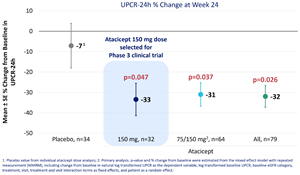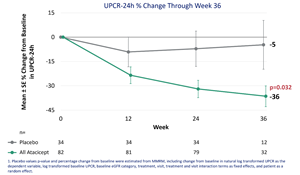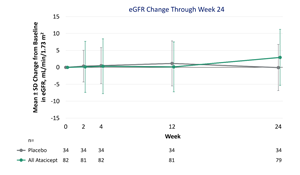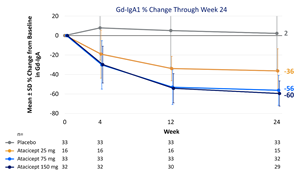-
Vera Therapeutics Announces Positive Topline Results of Phase 2b ORIGIN Clinical Trial of Atacicept for the Treatment of IgA Nephropathy
ソース: Nasdaq GlobeNewswire / 03 1 2023 16:01:00 America/New_York
Atacicept met primary endpoint at 24 weeks, and also achieved statistical significance in the 150 mg dose group with a 33% mean reduction in proteinuria from baseline, with available data showing trend towards further reductions in proteinuria at week 36
Atacicept safety profile in IgAN patients was similar to placebo
Vera plans to advance atacicept into a pivotal Phase 3 trial in the first half of 2023
Company to host investor conference call and webcast on January 4, 2023, at 8:00 a.m. ET to further discuss results
BRISBANE, Calif., Jan. 03, 2023 (GLOBE NEWSWIRE) -- Vera Therapeutics, Inc. (Nasdaq: VERA), a late-stage biotechnology company focused on developing and commercializing transformative treatments for patients with serious immunological disease, today announced the Phase 2b ORIGIN clinical trial of atacicept in patients with immunoglobulin A nephropathy (IgAN) met its primary endpoint.
Atacicept is the Company’s potential best-in-class, disease-modifying dual inhibitor of the cytokines B lymphocyte stimulator (BLyS) and a proliferation-inducing ligand (APRIL). ORIGIN is a multinational, randomized, double-blind, placebo-controlled clinical trial (n=116) evaluating the efficacy and safety of atacicept in patients with IgAN who continue to have persistent proteinuria and remain at high risk of disease progression despite available ACE or ARB therapy.
“IgAN is a serious and progressive autoimmune disease of the kidney, can severely impact quality of life as up to half of patients develop end-stage kidney disease, requiring dialysis or kidney transplant within 20 years of diagnosis,” said Jonathan Barratt, Ph.D., FRCP, The Mayer Professor of Renal Medicine, University of Leicester, U.K. “The positive topline results from the ORIGIN clinical trial demonstrate atacicept’s ability to reduce Gd-IgA1, the source of this disease, which in turn leads to clinically meaningful reductions in proteinuria at an early, 24-week time point, and is strongly supportive of a long-term benefit on kidney function. A 30% reduction in proteinuria at nine months has shown clear association with slowing of kidney function decline in patients with IgAN, and atacicept – having shown this in the ORIGIN clinical trial – is a promising potential therapy for chronic treatment of IgAN.”
Topline results from the Phase 2b ORIGIN clinical trial
The primary endpoint analysis, change in proteinuria as evaluated by urine protein creatinine ratio (UPCR) at week 24 of the pooled 75/150 mg dose groups, achieved statistical significance and showed a 31% mean reduction versus baseline (p=0.037 versus placebo). Statistical significance was also achieved in the individual 150 mg dose group with a 33% mean reduction in proteinuria versus baseline (p=0.047 versus placebo) and the all-atacicept group versus placebo, as shown in Figure 1.
Figure 1. UPCR-24h % Change at Week 24
A trend towards further reductions in proteinuria was observed in the all-atacicept group versus placebo with 38% of patient data available at Week 36, as shown in Figure 2.
Figure 2. UPCR-24h % Change through Week 36
The exploratory endpoint analysis, change in estimated glomerular filtration rate (eGFR), showed stabilization in the all-atacicept group through Week 24, as shown in Figure 3.
Figure 3. eGFR Change through Week 24
Atacicept robustly reduced galactose-deficient IgA1 (Gd-IgA1) from baseline through 24 weeks, as shown in Figure 4.
Figure 4. Gd-IgA1 % Change through Week 24
Safety results indicated that atacicept was generally well-tolerated and were consistent with the previously observed safety profile of atacicept, including a 1% discontinuation rate due to adverse events (AEs) and comparable rates of infection compared to placebo. Serious treatment-emergent AEs were observed in 2% of patients in all atacicept arms and in 9% of patients in the placebo arm. These results build upon the prior integrated analysis of atacicept in randomized, double-blind, placebo-controlled clinical trials in over 1,500 patients to date – in which atacicept was well-tolerated.
“We are very pleased to share these positive results from the ORIGIN clinical trial, demonstrating atacicept’s ability to not only significantly reduce Gd-IgA1, but also to improve kidney function, as measured by clinically meaningful reductions in proteinuria and stabilization of eGFR in a multinational, randomized, double-blind, placebo-controlled trial. This is an important milestone not only for Vera but for the entire IgAN community,” said Marshall Fordyce, M.D., Chief Executive Officer of Vera Therapeutics. “Atacicept could be a transformational treatment for patients with IgAN who currently have limited treatment options. We look forward to rapidly advancing the 150 mg dose into our planned Phase 3 pivotal trial.”
Next Steps
As a result of these positive data, Vera plans to advance atacicept into pivotal Phase 3 development in the first half of 2023, subject to and following discussions with the U.S. Food and Drug Administration. The full data sets from the ORIGIN clinical trial will be presented at a future medical meeting.Conference Call / Webcast Details
Vera will host a conference call and webcast with slide presentation at 8:00 a.m. ET on January 4, 2023. The live webcast will be available here, and on the Events & Presentations page of the Vera website, with the recording and presentation available immediately following the event.About the ORIGIN clinical trial
The ORIGIN clinical trial (NCT04716231) is a global, multicenter, randomized, double-blind, placebo-controlled Phase 2b trial evaluating the safety and efficacy of atacicept in 116 patients with IgAN who continue to have persistent proteinuria and remain at high risk of disease progression despite being on a stable prescribed regimen of RAASi for at least 12 weeks that is the maximum labeled or tolerated dose.The objectives of the study are to determine the effect of atacicept on proteinuria and preservation of renal function compared to placebo to determine the appropriate dose(s) for further clinical development.
The primary endpoint is the change in proteinuria as evaluated by UPCR at week 24 and the key secondary endpoint is the change in proteinuria as evaluated by UPCR at week 36.
Additional exploratory endpoints include change in proteinuria as evaluated by UPCR at weeks 12, 48, and 96; change in estimated glomerular filtration rate (eGFR); change in serum immunoglobulin levels, and serum Gd-IgA1 levels; safety and tolerability; and serum pharmacokinetics (PK).
The ORIGIN clinical trial evaluated three dose strengths of atacicept versus placebo, administered weekly by prefilled syringe, and their impact on the reduction of proteinuria as evaluated by urine protein to creatinine ratio (UPCR). Patients were randomized 2:2:1:2 to atacicept 150 mg, atacicept 75 mg, atacicept 25 mg, or matching placebo. Upon completion of the 36-week blinded treatment period, all patients are being offered open-label atacicept 150 mg for an additional 60 weeks. For more information about the ORIGIN clinical trial, please visit www.clinicaltrials.gov.
About IgA nephropathy (IgAN), or Berger’s disease
IgAN, also known as Berger’s disease, is a serious and progressive autoimmune disease of the kidney, for which there remains a high unmet medical need. IgAN is driven by the production of immunogenic galactose-deficient IgA1 (Gd-IgA1), which triggers autoantibodies that lead to the formation of pathogenic immune complexes, which become trapped in the kidney’s glomeruli, causing inflammation and progressive damage. In up to 50 percent of patients, IgAN can lead to end-stage renal disease (ESRD) or kidney failure, which has considerable morbidity and impact on patients’ lives.About Atacicept
Atacicept is an investigational recombinant fusion protein that contains the soluble transmembrane activator and calcium-modulating cyclophilin ligand interactor (TACI) receptor that binds to the cytokines B lymphocyte stimulator (BlyS) and a proliferation-inducing ligand (APRIL). These cytokines are members of the tumor necrosis factor family that promote B-cell survival and autoantibody production associated with certain autoimmune diseases, including IgA nephropathy and lupus nephritis. Atacicept showed a dose-dependent effect on key biomarkers and clinical markers in a Phase 2a clinical study. Vera believes atacicept is positioned for best-in-class potential, targeting B cells and plasma cells to reduce autoantibodies and having been administered to more than 1,500 patients in clinical studies across different indications.About Vera
Vera Therapeutics is a late-stage biotechnology company focused on developing treatments for serious immunological diseases. Vera’s mission is to advance treatments that target the source of immunologic diseases in order to change the standard of care for patients. Vera’s lead product candidate is atacicept, a fusion protein self-administered as a subcutaneous injection once weekly that blocks both B lymphocyte stimulator (BLyS) and a proliferation inducing ligand (APRIL), which stimulate B cells and plasma cells to produce autoantibodies contributing to certain autoimmune diseases, including IgA nephropathy (IgAN), also known as Berger’s disease, and lupus nephritis. In addition, Vera is evaluating additional diseases where the reduction of autoantibodies by atacicept may prove medically useful. Vera is also developing MAU868, a monoclonal antibody designed to neutralize infection with BK Virus, a polyomavirus that can have devastating consequences in certain settings such as kidney transplant. Vera retains all global developmental and commercial rights to atacicept and MAU868. For more information, please visit www.veratx.com.Forward-looking Statement
Statements contained in this press release regarding matters, events or results that may occur in the future are “forward-looking statements” within the meaning of the Private Securities Litigation Reform Act of 1995. Such forward-looking statements include statements regarding, among other things, atacicept’s potential to be a transformational treatment for patients with IgAN and a best-in-class therapy, Vera’s plans to advance atacicept into pivotal Phase 3 development in the first half of 2023, and regulatory matters, including the timing and likelihood of success in obtaining drug approvals. Because such statements are subject to risks and uncertainties, actual results may differ materially from those expressed or implied by such forward-looking statements. Words such as “could,” “will,” “potential,” “plan,” and similar expressions are intended to identify forward-looking statements. These forward-looking statements are based upon Vera’s current expectations and involve assumptions that may never materialize or may prove to be incorrect. Actual results could differ materially from those anticipated in such forward-looking statements as a result of various risks and uncertainties, which include, without limitation, risks related to the regulatory approval process, results of earlier clinical trials may not be obtained in later clinical trials, risks and uncertainties associated with Vera’s business in general, the impact of macroeconomic and geopolitical events, including the COVID-19 pandemic, and the other risks described in Vera’s filings with the Securities and Exchange Commission. All forward-looking statements contained in this press release speak only as of the date on which they were made and are based on management’s assumptions and estimates as of such date. Vera undertakes no obligation to update such statements to reflect events that occur or circumstances that exist after the date on which they were made, except as required by law.Contacts
Investor Contact:
Joyce Allaire
LifeSci Advisors
212-915-2569
jallaire@lifesciadvisors.comMedia Contact:
Uncapped Communications
uncappedverateam@uncappedcommunications.comPhotos accompanying this announcement are available at
https://www.globenewswire.com/NewsRoom/AttachmentNg/8b2035b1-8f70-4cd2-bc4d-39d19b99b074
https://www.globenewswire.com/NewsRoom/AttachmentNg/6a82646e-b5a1-47ef-91ad-9e7e65a1eb7a
https://www.globenewswire.com/NewsRoom/AttachmentNg/caad29cd-58a6-4b3d-b62b-2da28005a539
https://www.globenewswire.com/NewsRoom/AttachmentNg/fccdc35e-6930-4a82-806c-9acfb404418d

Figure 1. UPCR-24h % Change at Week 24
Figure 1. UPCR-24h % Change at Week 24
Figure 2. UPCR-24h % Change through Week 36
Figure 2. UPCR-24h % Change through Week 36
Figure 3. eGFR Change through Week 24
Figure 3. eGFR Change through Week 24
Figure 4. Gd-IgA1 % Change through Week 24
Figure 4. Gd-IgA1 % Change through Week 24




